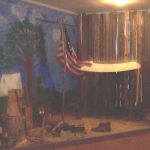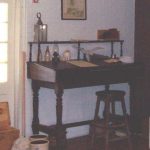Fort Jesup State Historic Site
Zachary Taylor Tames No-man’s Territory at Fort Jesup
Fort Jesup is a reminder of a young nation’s growing pains and a relic of Louisiana’s rich international heritage.
When the Louisiana Purchase Treaty of 1803 failed to define clearly the western boundary of Louisiana, which was also the western border of the country at that time, the United States claimed eastern Texas and Spain claimed western Louisiana. The ensuing dispute gave rise to the “Neutral Ground”, an area where the laws of neither nation were enforced. Soldiers and settlers were kept out and rogues of various stripes ruled the region. After the territorial boundary was finally fixed at the Sabine River by the Florida Purchase Treaty of 1819, the United States built Fort Jesup in 1822. Lieutenant Colonel Zachary Taylor established and commanded the garrison, which was originally called Cantonment Jesup in honor of Taylor’s good friend, Brigadier General Thomas Sidney Jesup. Taylor’s troops managed to establish law and order in the Neutral Ground and Fort Jesup remained an important military post for nearly 25 years.
Click on any image for an enlargement
History
During its life, Fort Jesup served the area in many ways. At various times soldiers were sent out to clear the Sabine River, to serve as Indian agents, or to help plantation owners along the Red River prevent slave insurrections. In addition, the post helped settlers feel secure against Indian raids. In 1845 Fort Jesup saw its most important duty. Lt. served as a staging area for troops preparing to enter Texas at the beginning of the Mexican War. The fort was abandoned in 1846 when it was no longer needed as a border outpost. In 1961, Fort Jesup was designated as a National Historic Landmark by the U.S. Department of the Interior and, as such, joined a select group of properties which have been recognized for their importance in American History.
Located on the historic San Antonio Road, the fort was once a large complex of 82 structures. Four companies of the Seventh Louisiana Infantry made up the first garrison of Fort Jesup. There were 141 officers and men. Another 51 soldiers manned Cantonment Taylor, a nearby temporary post established in 1823. Together they made this area the most securely garrisoned outpost in Louisiana.
The Kitchen-Mess Hall
One small kitchen is the only historic structure remaining from the large compound that once spread across the 22-acre site. It stands behind the ruins of high stone pillars which once supported the main floor of one of the soldiers quarters. The kitchen serviced the 20 to 25 men who were housed in the adjacent quarters. Cooking was always done in a detached building on plantations and military posts to reduce the danger of fire to people and property and also to keep heat and cooking odors away from the living areas.
This one-story kitchen structure, restored to its original appearance, is constructed of squared timbers laid atop one another with “waterproof” or slanted interlocking joints at the corners. The fireplace is made of stone and has a 71/2 foot opening in the hearth. The interior of this combination kitchen-mess hall has been furnished as it would have been in the 1840’s. Sturdy benches and tables made of native cypress, storage bins, plate rocks, washing and serving tables–all would have been built by the post carpenter. Iron and pewter utensils would have been purchased by the quartermaster in New Orleans and shipped up river to the fort. An old butcher block and a few other original articles have survived the years and have been returned to the kitchen. The ancient rustic structure stands as a tribute to the men who felled the timber and with broad ax and adze built this outpost in the Louisiana wilderness.
Officers’ Quarters
The reconstructed officers’ quarters houses a museum, meeting room and information center. There were originally four officers’ quarters buildings, which were built in the 1830’s and were located across the parade ground. Historians of the Quartermaster General’s Office and the National Trust for Historic Preservation assisted in the reconstruction effort.
Museum
The story of Fort Jesup is told in the museum with the use of maps, documents, illustrations and military artifacts. A diorama shows the fort under construction in the 1830’s. In the main building, the Commanding Officer’s bedroom is furnished as it would have appeared when General Taylor occupied it in 1845.
Fort Jesup provides a unique glimpse of life when Louisiana was still part of the nation’s frontier. Today the pleasant noises of picnickers beside the ponds have replaced the sounds of horses and the cadences of marching drills. What was once an important part of our nation’s system of defense is now a site for everyone to learn about and enjoy . . . Fort Jesup State Commemorative Area.
Programs at Ft. Jesup: Ft. Jesup regularly presents programs of historical interest. Check the Area Calendar of Events to see what is coming up.
DIRECTIONS:
FROM MANY, LA – Take Highway 6 East for about 6 miles to the old San Antonio Road – Highway 3118. Turn onto Highway 3118 (it makes a loop and both ends of it connect to Highway 6) and proceed to Fort Jesup.
Fort Jesup State Commemorative Area
32 Geoghagan Road
Many, LA 71449
Phone: (318) 256-4117
1 (888) 677-5378 toll free
Photos by Frank Dutton – Toledo-Bend.Com
















